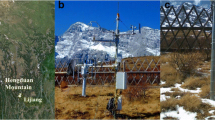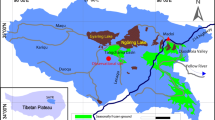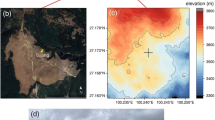Abstract
On the Tibetan Plateau, the alpine meadow is the most widespread vegetation type. The alpine meadow has a low biological productivity and low vegetation coverage in the growing season. The daytime NEE between the atmosphere and the alpine meadow ecosystem was influenced by solar radiation. To analyze the characteristics of change in NEE and to calculate the parameters related to photosynthesis and respiration in different solar radiation environments, the NEE measurements were taken in Damxung from July to August in 2003, 2004, 2005 and 2006 using the eddy covariance technique. Solar radiation was grouped into three levels according to the net radiation, which was more than 155 W m−2 d−1 on clear days, 144±5 W m−2 d−1 on partly cloudy days and less than 134 W m−2 d−1 on cloudy days. The diurnal relationships between NEE and PAR varied with differences in solar radiation, which was a rectangular hyperbola form on clear days, two different concave curves on partly cloudy days and an irregular triangle form on cloudy days. The mean CO2 absorption rate showed a decreasing trend with increasing solar radiation. The daytime absorption maximum occurred around 10:00 on clear days with an average of slightly less −0.2 mg m−2 d−1, around 11:00 on partly cloudy days with an average of about −0.2 mg m−2 d−1, and around 12:00 on cloudy days with an average of about −0.25 mg m−2 d−1. As solar radiation increased, the Amax and the Q10 decreased. However, the R10 increased and the maximum of the α occurred on partly cloudy days. The optimum net solar radiation was about 134–155 W m−2 d−1, which induced a PAR of about 1800–2000 μmol m−2 s−1 and soil temperature at a depth of 5 cm of about 14°C. Therefore, on the Tibetan Plateau, the alpine meadow ecosystem will have a higher carbon absorption potential while solar radiation decreases in the future.
Similar content being viewed by others
References
Aguilera J, Karsten U, Lippert H et al., 1999. Effects of solar radiation on growth, photosynthesis and respiration of marine macroalgar from the arctic. Marine Ecology Progress Series, 191: 109–119.
Alward R D, Detling J K, Milchunas D G, 1999. Grassland vegetation changes and nocturnal global warming. Science, 283(5399): 229–231.
Baldocchi D, Falge E, Gu L H et al., 2001. Fluxnet: A new tool to study the temporal and spatial variability of ecosystem-scale carbon dioxide, water vapor, and energy flux densities. Bulletin of the American Meteorological Society, 82(11): 2415–2434.
Baldocchi D D, Hicks B B, Meyers T P, 1985. Measuring biosphere-atmosphere exchange of biologically related gases with micrometeorological methods. Ecology, 69(5): 1331–1340.
Bernhofer C, Aubinet M, Clement R et al., 2003. Spruce forests (Norway and Sitka spruce, including Douglas fir): Carbon and water fluxes, balances, ecological and ecophysiological determinants. Ecological Studies, 164: 99–124.
Chen Yunhao, Li Xiaobing, Shi Peijun, 2001. Regional evapotranspiration estimation over Northwest China using remote sensing. Acta Geographica Sinica, 56(3): 261–268. (in Chinese)
Davies J A, 2006. A note on the relationship between net radiation and solar radiation. Quarterly Journal of the Royal Meteorological Society, 93(395): 109–115.
Falge E, Baldocchi D, Olson R et al., 2001. Gap filling strategies for defensible annual sums of net ecosystem exchange. Agricultural and Forest Meteorology, 107(1): 43–69.
Fan Yuzhi, Zhang Xianzhou, Shi Peili, 2009. Influence of diffuse radiation on the net CO2 exchange of alpine meadow ecosystem on Tibet Plateau. Geographical Research, 28(6): 1673–1681. (in Chinese)
Fang C, Moncrieff J B, 2001. The dependence of soil CO2 efflux on temperature. Soil Biology and Biochemistry, 33(2): 155–165.
Flanagan L B, Johnson B G, 2005. Interacting effects of temperature, soil moisture and plant biomass production on ecosystem respiration in a northern temperate grassland. Agricultural and Forest Meteorology, 130(3/4): 237–253.
Hu Qiwu, Cao Guangmin, Wu Qin et al., 2004. Comparative study on CO2 emissions from different types of alpine meadows during grass exuberance period. Journal of Geographical Sciences, 14(2): 167–176.
Kuhn W R, Atreya S K, 1979. Solar radiation incident on the Martian surface. Journal of Molecular Evolution, 14(1): 57–64.
Lloyd J, Taylor J, 1994. On the temperature dependence of soil respiration. Functional Ecology, 8(3): 315–323.
Lu Heli, Shao Quanqin, Liu Jiyuan et al., 2008. Cluster analysis on summer precipitation field over Qinghai-Tibet Plateau from 1961 to 2004. Journal of Geographical Sciences, 18(3): 295–307.
McCree K J, 1972. The action spectrum, absorptance and quantum yield of photosynthesis in crop plants. Agricultural Meteorology, 9(3/4): 191–216.
Nakano T, Nemoto M, Shinoda M, 2008. Environmental controls on photosynthetic production and ecosystem respiration in semi-arid grasslands of Mongolia. Agricultural and Forest Meteorology, 148(10): 1456–1466.
Pinker R, Zhang B, Dutton E G, 2005. Do satellites detect trends in surface solar radiation? Science, 308(5723): 850–854.
Ruimy A, Jarvis P G, Baldocchi D D et al., 1995. CO2 fluxes over plant canopies and solar radiation: A review. Advances in Ecological Research, 26: 1–68.
Schrott L, 1991. Global solar radiation, soil temperature and permafrost in the Central Andes, Argentina: A progress report. Permafrost and Periglacial Processes, 2(1): 59–66.
Shi Peili, Sun Xiaomin, Xu Lingling et al., 2006. Net ecosystem CO2 exchange and controlling factors in a steppe—Kobresia meadow on the Tibetan Plateau. Science in China (Series D), 49(Suppl. 2): 207–218. (in Chinese)
Tang Maochang, Li Cunqiang, Zhang Jian, 1988. Recent climate change in Qinghai-Tibet Plateau and its vicinity. Plateau Meteorology, 7(1): 39–49.
Tjoelker M G, Oleksyn J, Reich P B, 2008. Modelling respiration of vegetation: Evidence for a general temperature-dependent Q10. Global Change Biology, 7(2): 223–230.
Walsh J E, Chiapman W L, 1998. Arctic cloud-radiation-temperature associations in observational data and atmospheric reanalyses, Journal of Climate, 11(11): 3030–3045.
Wang Genxu, Cheng Guodong, Shen Yongping et al., 2003. Influence of land cover changes on the physical and chemical properties of alpine meadow soil. Chinese Science Bulletin, 48(2): 118–124. (in Chinese)
Wang Keli, 1996. Effect of cloud on the surface net radiation over the Qinghai-Xizang Plateau. Plateau Meteorology, 15(3): 269–275. (in Chinese)
Wang Keli, Hou P, Zhong Q, 1994. Effect of cloud on the surface effective radiation over the Qinghai-Xizang Plateau. Plateau Meteorology, 13(1): 57–64. (in Chinese)
Weng Duming, Gao Qingxian, 1993. Climatological research on correlation between global radiation and surface net radiation. Journal of Nanjing Institute of Meteorology, 16(3): 288–294. (in Chinese)
Wohlfahrt G, Bahn M, Haslwanter A et al., 2005. Estimation of daytime ecosystem respiration to determine gross primary production of a mountain meadow. Agricultural and Forest Meteorology, 130(1/2): 13–25.
Xu Lingling, 2006. Measurement and modelling of the net ecosystem carbon dioxide exchange on Tibetan Plateau alpine meadow ecosystem and its response to global climate change [D]. Beijing: Institute of Geographic Sciences and Natural Resources Research, Chinese Academy of Sciences. (in Chinese)
Xu Lingling, Zhang Xianzhou, Shi Peili et al., 2004. The apparent quantum yield and maximum photosynthesis rate in alpine meadow on the Tibetan Plateau. Science in China (Series D), 34(Suppl. 2): 125–130. (in Chinese)
Xu Lingling, Zhang Xianzhou, Shi Peili et al., 2005. Net ecosystem carbon dioxide exchange of alpine meadow in the Tibetan Plateau from August to October. Acta Ecologica Sinica, 25(8): 1948–1952. (in Chinese)
Xu Lingling, Zhang Xianzhou, Shi Peili et al., 2007. Modeling the maximum apparent quantum use efficiency of alpine meadow ecosystem on Tibetan Plateau. Ecological Modelling, 208(2–4): 129–134.
Hurtt G C, Rosentrater L, Frolking S et al., 2001. Spatial and seasonal variations of Q10 determined by soil respiration measurements at a Sierra Nevadan forest. Global Biogeochemical Cycles, 15(3): 673–685.
Yan Wei, Zhang Xianzhou, Shi Peili et al., 2006. Carbon dioxide exchange and water use efficiency of alpine meadow ecosystems on the Tibetan Plateau. Journal of Natural Resources, 21(5): 756–767. (in Chinese)
Zhang Bingsong, Shi Peili, He Yongtao et al., 2009. The climate feature of Damxung alpine meadow carbon flux research station on the Tibetan Plateau. Journal of Mountain Science, 27(1): 88–95. (in Chinese)
Zhang Xianzhou, 1999. Energy input and production of farmland ecosystem on the Tibetan Plateau and its response to global change [D]. Institute of Geographic Sciences and Natural Resources Research, Chinese Academy of Sciences. (in Chinese)
Zhang X Z, Shi P L, Liu Y F et al., 2004. Soil carbon emission and balance in an alpine meadow ecosystem on the Tibetan Plateau. Science in China (Series D), 34 (Suppl. 2): 193–199. (in Chinese)
Zhang Xianzhou, Wang Qidong, Zhang Yiguang, 1996. The spectral measurement of the solar global radiation on Tibetan Plateau during April-October. Acta Meteorologica Sinica, 54(5): 620–624. (in Chinese)
Zhang Xueqin, Peng Lili, Zheng Du et al., 2007. Variation of total cloud amount and its possible causes over the Qinghai-Xizang Plateau during 1971–2004. Acta Geographica Sinica, 62(9): 959–969. (in Chinese)
Zhao Liang, Gu Song, Xu Shixiao et al., 2007. Carbon flux and controlling process of alpine meadow on Qinghai-Tibetan Plateau. Acta Botanica Boreali-Occidentalia Sinica, 27(5): 859–863. (in Chinese)
Zhu Baowei, 1992. Plateau climate and agricultural ecological environment. Tibetan Science and Technology, (2): 32–34. (in Chinese)
Author information
Authors and Affiliations
Corresponding author
Additional information
Foundation: The Major Basic Research Development Program of China, No.2010CB833501; No.2010CB951704; Knowledge Innovation Program of Chinese Academy of Sciences, No.KSCXZ-YW-N-44; Knowledge Innovation Program of IGSNRR, CAS, No.Y0V00230ZZ
Author: Fan Yuzhi, Ph.D, specialized in plant physiological ecology and ecosystem ecology.
Rights and permissions
About this article
Cite this article
Fan, Y., Zhang, X., Wang, J. et al. Effect of solar radiation on net ecosystem CO2 exchange of alpine meadow on the Tibetan Plateau. J. Geogr. Sci. 21, 666–676 (2011). https://doi.org/10.1007/s11442-011-0871-4
Received:
Accepted:
Published:
Issue Date:
DOI: https://doi.org/10.1007/s11442-011-0871-4




